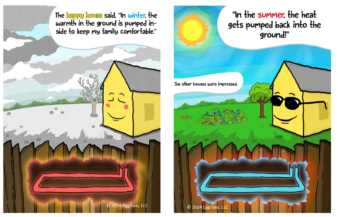Recently, I had the opportunity to talk with noted plumbing and heating contractor, Dave Yates, F.W. Behler, York, Pa., about the upcoming lead-free legislation. On January 4, 2014 Federal Law mandates the wetted surface of every pipe, fixture, and fitting sold for or installed in potable water applications not contain more than 0.25% lead by weight. Are we ready as an industry? You might be surprised by the conversation.
 MH: Manufacturers have worked very diligently to turn over their lines to lead free. Do you think all contractors are aware of this new law, and being proactive about this?
MH: Manufacturers have worked very diligently to turn over their lines to lead free. Do you think all contractors are aware of this new law, and being proactive about this?
Yates: In a word: No. Contractors I’ve spoken with either are aware and don’t care or not aware and don’t care. Why? Because there’s no enforcement and they have inventory to use. In addition, some took advantage of deep discounted sales when wholesalers unloaded leaded products.
MH: Do you feel that there will be some that try to get away with installing the leaded material (cheaper in cost)?
Yates: Guaranteed. We will lose bids as a result. One example that comes to mind: testable backflow prevention devices. There is a fairly substantial increase in the cost – more than enough to sway an unsuspecting customer.
MH: How much more of an cost increase will you see in materials?
Yates: 10% to 50% depending on the product.
MH: Enforcement. To your knowledge, who is going to enforce this? Is it a local jurisdiction, federal?
Yates: John, enforcement of plumbing codes in my neck of the woods is already lax. This will be up to local inspectors to enforce. Unlike the 50/50 solder test swab kits that revealed immediately the presence of lead, I am not yet aware of a similar test kit for low-lead products. That said, plumbing inspectors do not inspect the potable water lines and concentrate on the DWV side. Even today it is rare for an inspector to check scald-guard faucets for final delivery temperature. One of the local PI’s measures, are you ready, with his fingers to determine if the water delivery temp is set for 120F. Given that pressure balance valves are accepted and less expensive to purchase, that ensures virtually all are PB models and that 120F setting can only be guaranteed for that moment in time. As municipal water delivery temperatures vary from 40F to 85F across the seasons, so does that final 120F. And that’s looking only at the professional plumbers’ side of things! Toss in the trunk slammers and weekend warriors and you can pretty much toss the codes out with yesterday’s newspaper.
Short answer: I’ll be pleasantly surprised if anyone enforces this low-lead rule. Suppliers are leading the charge (most of them) by having already switched to all low-lead products. I fully expect to see internet sales of leaded products with predatory pricing that will attract those who choose to be blind to the regulations or are looking for the cheapest pricing.
MH: Piggybacking off the previous question, do you foresee potential problems with enforcement then?
Yates: Other than new construction that breaks ground after the inception, yes. How will an inspector know what was installed when? Since no permit or inspection is required for repair/retrofit work, it’s going to be a let the buyer beware. See next Q’s answer.
MH: Is there a uniform marking on lead free materials so contractors and inspectors can identify easier?
Yates: The seminars I have attended put on by manufacturing companies have told us NO with the exception of valve handles being white. Goes right back to inexpensive test kits for inspectors.
MH: Does it make sense to “grandfather” leaded materials in existing homes? What about the piping that comes into the homes from the municipalities? Isn’t this about the health of the consumer, especially children?
Yates: I, too, wondered about that issue and we do have some areas locally with lead service lines. I called Rob Bissey with York Water Co to ask those same questions. Rob told me YWC had done extensive testing on three distinct separate sets of circumstances: homes with lead service lines; homes with 50/50 solder; and homes with “lead-free” solder. Rob asked me which one of those three came closest to exceeding the allowable limits for lead in potable water? If you guessed lead service line homes, as I did, you’d be wrong – it was the homes with 50/50 solder.
I also asked the manufacturers in those seminars. Turns out not one single leaded product exceeded the established limits for PPM of lead in the potable water during testing. Some came close, but none were past the allowable limit.
Lead in potable water & children don’t do well together. All manner of illnesses arise, including permanent reading disabilities. I grew up in a home with 50/50 solder and acidic well water that routinely resulted in pin-hole leaks. I am dyslexic. I was the only one in our family to be born and grow up as a young child in that old log cabin turned one room school house turned farm house that became our home.
MH: Are most of the supply houses ready?
Yates: Almost all of our local supply houses have been proactive and gone 100% low-lead. Only a few have dual inventories. One will be requiring all sales to have the purchaser sign a statement that the installed leaded components will be either in a non-potable or serve fixtures (like toilets) that are exempt from enforcement.
MH: As I understand it, you can still purchase the leaded materials for non-potable use such as hydronics. Do you think there will be some crossover use or some of these materials mistakenly installed for potable applications?
Yates: I’d bet on it.
MH: To learn up on this, where would you suggest contractors go?
Yates: There are some great industry resources such as www.weareleadfree.net and http://www.gettheleadoutplumbing.com.
Here are some other columns I wrote for Contractor magazine. I had to blow the dust off of these old columns:
http://contractormag.com/yates/get-lead-out http://contractormag.com/plumbing/cm_column_97 and http://contractormag.com/plumbing/cm_column_103
Even way back in 2000, Contractor Magazine was ahead of its time with this information.
In the final analysis, I have to ask myself but one question regarding the new standards and if this is all just a big PITA: what price do we place on the health, safety, and welfare of our customers? The poster that hangs on my office wall – straight in front of me where it meets my gaze — is the Plumber Protects the Health of the Nation. Looking back over the history of my firm that began prior to 1900, we have been present from the first efforts to enhance the safety of plumbing systems and all professional plumbers will continue the unrelenting march forward while protecting and enhancing our customers’ health, safety and welfare.




Join the conversation: